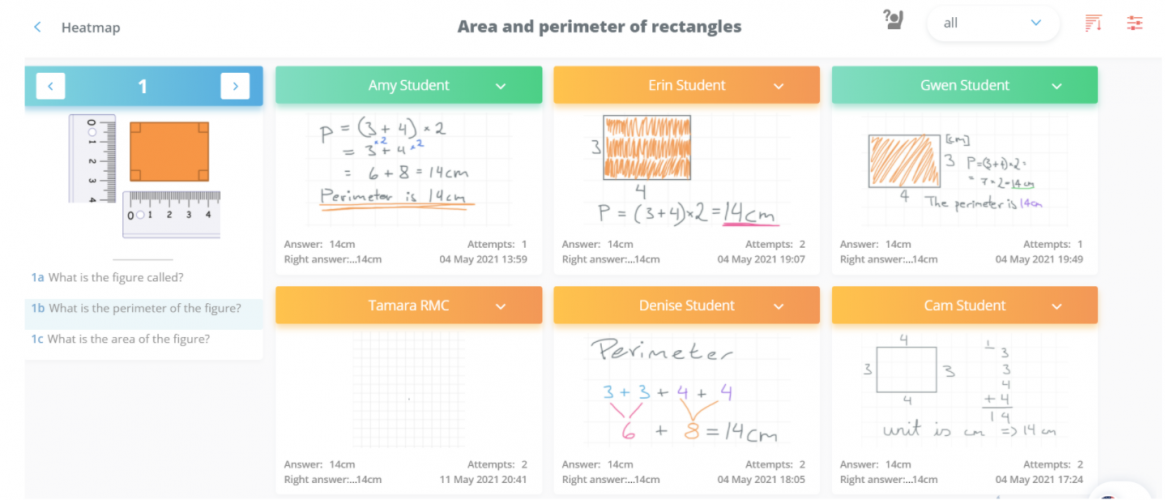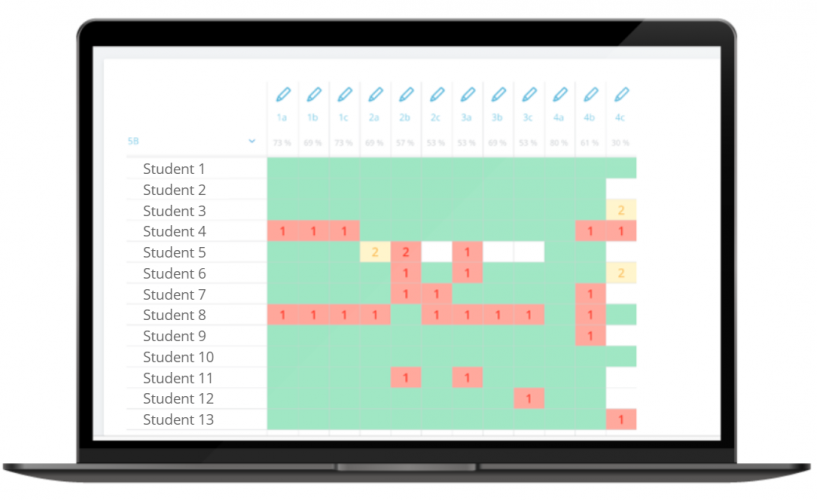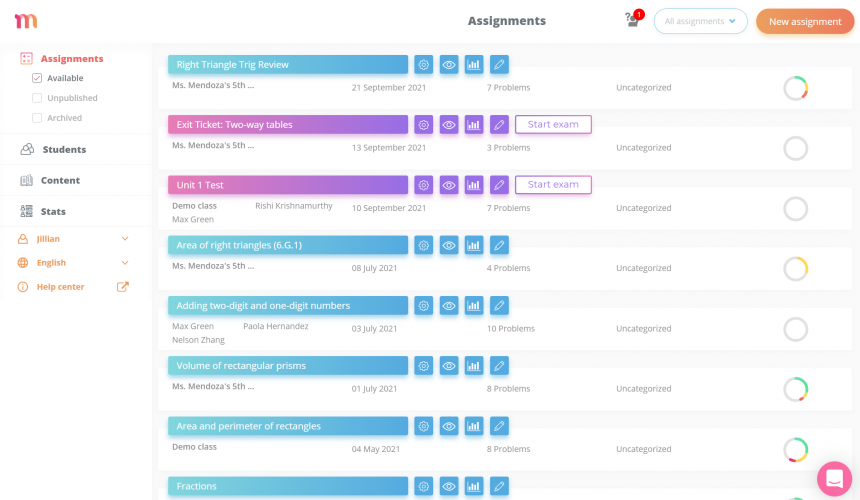Use place value understanding to round multi-digit whole numbers to any place.
Interpret products of whole numbers, e.g., interpret 5 × 7 as the total number of objects in 5 groups of 7 objects each.
Interpret whole-number quotients of whole numbers.
Use multiplication and division within 100 to solve word problems in situations involving equal groups, arrays, and measurement quantities.
Determine the unknown whole number in a multiplication or division equation relating three whole numbers.
Understand properties of multiplication and the relationship between multiplication and division.
Apply properties of operations as strategies to multiply and divide.
Understand division as an unknown-factor problem.
Multiply and divide within 100.
Fluently multiply and divide within 100, using strategies such as the relationship between multiplication and division or properties of operations.
Solve problems involving the four operations, and identify and explain patterns in arithmetic.
Solve two-step word problems using the four operations. Represent these problems using equations with a letter standing for the unknown quantity.
Identify arithmetic patterns (including patterns in the addition table or multiplication table), and explain them using properties of operations.
Use place value understanding and properties of operations to perform multi-digit arithmetic.
Use place value understanding to round whole numbers to the nearest 10 or 100.
Fluently add and subtract within 1000 using strategies and algorithms based on place value and properties of operations.
Multiply one-digit whole numbers by multiples of 10 in the range 10–90 using strategies based on place value and properties of operations.
Develop understanding of fractions as numbers.
Understand a fraction 1/b as the quantity formed by 1 part when a whole is partitioned into b equal parts.
Understand a fraction as a number on the number line; represent fractions on a number line diagram.
Explain equivalence of fractions in special cases, and compare fractions by reasoning about their size.
Solve problems involving measurement and estimation of intervals of time, liquid volumes, and masses of objects
Tell and write time to the nearest minute and measure time intervals in minutes. Solve word problems involving addition and subtraction of time intervals in minutes.
Measure and estimate liquid volumes and masses of objects using standard units of grams (g), kilograms (kg), and liters (l).
Represent and interpret data.
Draw a scaled picture graph and a scaled bar graph to represent a data set with several categories.
Generate measurement data by measuring lengths using rulers marked with halves and fourths of an inch.
Geometric measurement: understand concepts of area and relate area to multiplication and to addition.
Recognize area as an attribute of plane figures and understand concepts of area measurement.
Measure areas by counting unit squares (square cm, square m, square in, square ft, and improvised units).
Relate area to the operations of multiplication and addition.
Geometric measurement: recognize perimeter as an attribute of plane gures and distinguish between linear and area measures.
Solve real world and mathematical problems involving perimeters of polygons, including finnding the perimeter given the side lengths and an unknown side length.
Reason with shapes and their attributes.
Understand that shapes in different categories may share attributes, and that the shared attributes can de ne a larger category.
Partition shapes into parts with equal areas. Express the area of each part as a unit fraction of the whole.
Use the four operations with whole numbers to solve problems.
Interpret a multiplication equation as a comparison. Represent verbal statements of multiplicative comparisons as multiplication equations.
Multiply or divide to solve word problems involving multiplicative comparison.
Solve multistep word problems posed with whole numbers and having whole-number answers using the four operations.
Gain familiarity with factors and multiples.
Find all factor pairs for a whole number in the range 1–100. Recognize that a whole number is a multiple of each of its factors.
Generate and analyze patterns.
Generate a number or shape pattern that follows a given rule. Identify apparent features of the pattern that were not explicit in the rule itself.
Generalize place value understanding for multi-digit whole numbers
Recognize that in a multi-digit whole number, a digit in one place represents ten times what it represents in the place to its right.
Read and write multi-digit whole numbers using base-ten numerals, number names, and expanded form.
Compare two multi-digit numbers based on meanings of the digits in each place, using >, =, and < symbols to record the results of comparisons.
Represent and solve problems involving multiplication and division.
Fluently add and subtract multi-digit whole numbers using the standard algorithm.
Multiply a whole number of up to four digits by a one-digit whole number, and multiply two two-digit numbers, using strategies based on place value and the properties of operations.
Find whole-number quotients and remainders with up to four-digit dividends and one-digit divisors, using strategies based on place value, the properties of operations.
Extend understanding of fraction equivalence and ordering.
Recognize and generate equivalent fractions.
Compare two fractions with different numerators and different denominators.
Build fractions from unit fractions by applying and extending previous understandings of operations on whole numbers.
Understand a fraction a/b with a > 1 as a sum of fractions 1/b.
Apply and extend previous understandings of multiplication to multiply a fraction by a whole number.
Understand decimal notation for fractions, and compare decimal fractions.
Express a fraction with denominator 10 as an equivalent fraction with denominator 100, and use this technique to add two fractions with respective denominators 10 and 100.
Use decimal notation for fractions with denominators 10 or 100.
Compare two decimals to hundredths by reasoning about their size. Recognize that comparisons are valid only when the two decimals refer to the same whole.
Solve problems involving measurement and conversion of measurements from a larger unit to a smaller unit.
Know relative sizes of measurement units within one system of units including km, m, cm; kg, g; lb, oz.; l, ml; hr, min, sec.
Apply the area and perimeter formulas for rectangles in real world and mathematical problems.
Make a line plot to display a data set of measurements in fractions of a unit (1/2, 1/4, 1/8).
Geometric measurement: understand concepts of angle and measure angles.
Recognize angles as geometric shapes that are formed wherever two rays share a common endpoint, and understand concepts of angle measurement.
Measure angles in whole-number degrees using a protractor. Sketch angles of speci ed measure.
Recognize angle measure as additive.
Draw and identify lines and angles, and classify shapes by properties of their lines and angles.
Draw points, lines, line segments, rays, angles, and perpendicular and parallel lines. Identify these in two-dimensional figures.
Classify two-dimensional figures based on the presence or absence of parallel or perpendicular lines, or the presence of angles of a specified size.
Recognize right triangles as a category, and identify right triangles.
Recognize a line of symmetry for a two-dimensional figure as a line across the figure such that the figure can be folded along the line into matching parts.
Write and interpret numerical expressions.
Use parentheses, brackets, or braces in numerical expressions, and evaluate expressions with these symbols.
Write simple expressions that record calculations with numbers, and interpret numerical expressions without evaluating them.
Analyze patterns and relationships.
Generate two numerical patterns using two given rules. Identify apparent relationships between corresponding terms.
Understand the place value system.
Read, write, and compare decimals to thousandths.
Explain patterns in the number of zeros of the product when multiplying a number by powers of 10.
Use place value understanding to round decimals to any place.
Perform operations with multi-digit whole numbers and with decimals to hundredths.
Fluently multiply multi-digit whole numbers using the standard algorithm.
Find whole-number quotients of whole numbers with up to four-digit dividends and two-digit divisors.
Add, subtract, multiply, and divide decimals to hundredths, using concrete models or other strategies.
Use equivalent fractions as a strategy to add and subtract fractions.
Solve word problems involving addition and subtraction of fractions referring to the same whole.
Apply and extend previous understandings of multiplication and division to multiply and divide fractions.
Interpret a fraction as division of the numerator by the denominator.
Apply and extend previous understandings of multiplication to multiply a fraction or whole number by a fraction.
Interpret multiplication as scaling.
Solve real world problems involving multiplication of fractions and mixed numbers, by using visual fraction models or equations to represent the problem.
Apply and extend previous understandings of division to divide unit fractions by whole numbers and whole numbers by unit fractions.
Convert like measurement units within a given measurement system.
Convert among different-sized standard measurement units and use these conversions in solving multi-step, real world problems.
Geometric measurement: understand concepts of volume and relate volume to multiplication and to addition.
Recognize volume as an attribute of solid figures and understand concepts of volume measurement.
Measure volumes by counting unit cubes, using cubic cm, cubic in, cubic ft, and improvised units.
Relate volume to the operations of multiplication and addition and solve real world and mathematical problems involving volume.
Graph points on the coordinate plane to solve real-world and mathematical problems.
Classify two-dimensional figures into categories based on their properties.
Understand that attributes belonging to a category of two- dimensional figures also belong to all subcategories of that category.
Classify two-dimensional gures in a hierarchy based on properties.








User reviews for Magma Math
You need to log in to post a review.